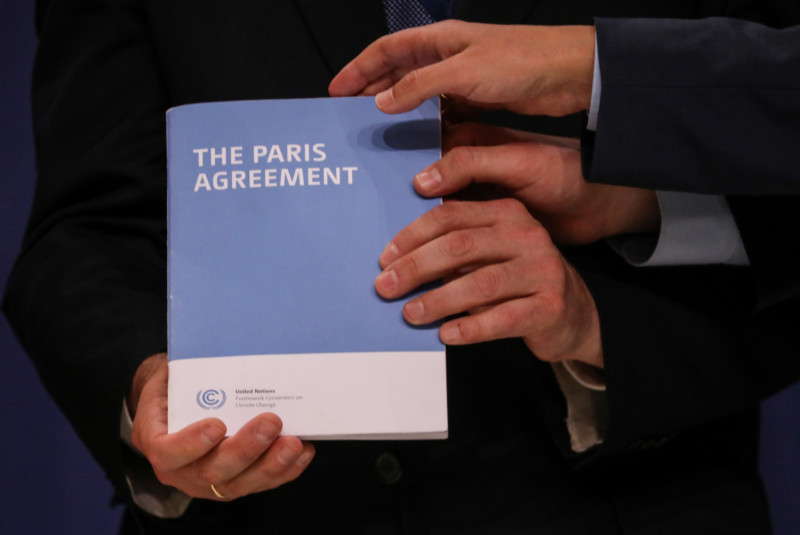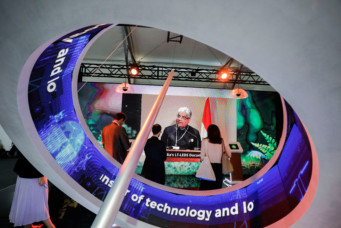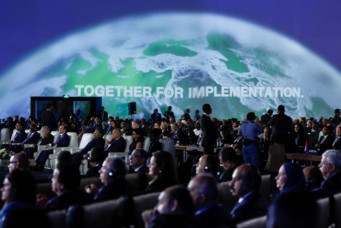Timeline: Environmental Diplomacy from Rio to COP27
Key moments in environmental diplomacy from the historic “Earth Summit” held in Rio de Janeiro, Brazil, in 1992 up to COP27 in Sharm El-Sheikh, Egypt, in November, 2022.

COP25 leaders hold a copy of The Paris Agreement during COP25 in Madrid, Spain, Dec. 13, 2019. Susana Vera/Reuters
While climate change impacts all nations and peoples of the world, not all nations take an equitable stance to ameliorate climate damage. Environmental diplomacy is full of lofty goals and ideals, but disagreements have historically been commonplace from nations with high carbon emissions. For this reason, global leaders have not always been able to reach agreements at the annual Conference of the Parties (COP) of the United Nations Framework Convention on Climate Change, and to this day environmental activists condemn diplomats for not doing enough. This timeline will cover key moments in environmental diplomacy from the historic “Earth Summit” held in Rio de Janeiro, Brazil, in 1992 up to COP27 in Sharm El-Sheikh, Egypt, in November, 2022.
June 3 to June 14, 1992: World leaders gathered in Rio de Janeiro, Brazil for the United Nations Conference on Environment and Development (UNCED). This conference created a new framework for countries to take action toward sustainable development. For example, UNCED created Agenda 21, which detailed how nations could preserve natural resources and encouraged governments to make international trade policies centered around sustainable development. Also known as the “Earth Summit,” this conference was the catalyst that sparked the global conversation about environmental diplomacy.
March 21, 1994: The United Nations Framework Convention on Climate Change (UNFCCC) entered into force after being adopted in 1992, committing signatories to work toward stabilizing the amount of greenhouse gasses in the atmosphere to prevent “dangerous anthropogenic interference with the climate system”.
1995: The Intergovernmental Panel on Climate Change issued a Second Assessment Report and concluded that evidence suggested that, “carbon dioxide remains the most important contributor to anthropogenic forcing of climate change.” This marked the first definitive statement that humans are responsible for climate change.
March 28 to April 7, 1995: The first Conference of the Parties (COP) of the UNFCCC took place in Berlin. The conference resulted in the Berlin Mandate, which established a process for dealing with climate change. The conference also created a separate body called the Ad Hoc Group on the Berlin Mandate, which would hold a series of negotiating sessions from 1995 that would culminate with the adoption of the Kyoto Protocol.
December 1 to December 10, 1997: At COP3, leaders agreed to the first legally binding climate treaty entitled the Kyoto Protocol, which committed industrialized economies and economies in transition to reducing greenhouse gas emissions according to country-specific targets. The protocol focused on developed countries like the United States and its carbon emissions rather than placing the greater burden on developing countries like China or India.
November 2 to November 13, 1998: The fourth COP took place in Buenos Aires, Argentina, and it culminated with the Buenos Aires Plan of Action. The plan was not able to fully realize ideals set forth within the previous Kyoto Protocol.
October 25 to November 5, 1999: At COP5 in Bonn, Germany, leaders discussed transitioning the ideas within the Kyoto Protocol into realities. One of the achievements, according to the White House Initiative on Global Climate Change, was to more than double the time dedicated to negotiations at the upcoming conference.
November 13 to November 25, 2000: Diplomacy surrounding COP6 at The Hague was not productive, as leaders from the United States and Europe could not reach consensus over “carbon sinks” and nuclear energy. According to climate change analysts, developing countries were sidelined from this dialogue.
March 2001: Former U.S. President George W. Bush withdrew the United States from the Kyoto Protocol. While former U.S. Vice President Al Gore participated in the creation of the protocol in 1997, and former U.S. President Bill Clinton signed it in 1998, the U.S. Senate never ratified the treaty. One of the reasons that Bush withdrew was because the protocol would allegedly harm the U.S. economy while not penalizing developing countries.
July 23, 2001: Global governments agreed upon an operational rulebook in reference to the Kyoto Protocol known as the Bonn Agreement. The agreement established a climate change fund for less developed countries to assist in the adoption of green technology and in efforts to lower carbon emissions.
October 29 to November 10, 2001: Finance was a focal point of COP7 in Marrakech, Morocco. Leading finance companies were encouraged to innovate products and services designed to reduce greenhouse gas emissions.
October 23, to November 1, 2002: COP8 in New Delhi, India, began with acknowledgement of the poor progress made regarding previous climate agreements and was dubbed “a COP between COPs”. Without the ratification of the Kyoto Protocol by the United States, climate progress appeared dismal.
December 1 to December 12, 2003: Leaders at COP9 in Milan, Italy, agreed to use the Adaptation Fund to help developing countries with climate change finance.
December 6 to December 17, 2004: Discussions at COP10 in Buenos Aires, Argentina, focused on climate change adaptation measures, technology, and enforcement potential of the Kyoto Protocol. Observers pointed out that this COP, like climate issues in general, did not get enough coverage by “mainstream” media.
February 16, 2005: The Kyoto Protocol entered into force.
November 28 to December 9, 2005: At COP11 in Montreal, the “rulebook” of the Kyoto Protocol was adopted, which set up the mechanisms for countries to follow through and measure their progress for commitments made in the Kyoto Protocol. The United States, having withdrawn from the Kyoto Protocol in 2001, made clear its position: that matters under the Kyoto Protocol should be separate from matters of the UNFCCC.
November 6 to November 17, 2006: Acting Secretary-General for the Organization of the Petroleum Exporting Countries Mohammed Barkindo delivered a speech to the twelfth COP session in Nairobi, Kenya, stating that “for developing countries, poverty alleviation, economic development and social progress are the overriding priorities”— a reminder that although developing countries were not major contributors to carbon emissions, they were still facing negative ramifications from climate change.
December 3 to December 14, 2007: COP13 adopted the Bali Action Plan, containing five categories: shared vision, mitigation, adaptation, technology, and financing.
December 1 to December 12, 2008: COP14 in Poznan, Poland, included discussions about a post-Kyoto international agreement on climate change to be implemented in 2013. Leaders reiterated the urgency that climate change presents. While significant progress was made in some areas, such as the Adaptation Fund, most negotiations made little progress.
September 2009: Prior to COP15, former UN Secretary-General Ban Ki-moon hosted a United Nations summit, which he stated was the largest ever gathering of heads of states and governments on climate change. During the meeting, then-Chinese President Hu Jintao announced an unprecedented plan for China to reduce greenhouse gas emissions by 2020, while former U.S. President Barack Obama did not offer any proposals.
December 7 to December 18, 2009: COP15 took place in Denmark and produced the Copenhagen Accord. This document outlined a goal to limit global temperature increase to 2 degrees Celsius. Additionally, it delineated another goal that called for the creation of a Green Climate Fund to support climate projects and policies in developing countries.
November 29 to December 10, 2010: A temperature target was set at COP16 in Cancun, Mexico, via the Cancun Agreements. As 2000-2009 was recorded as the warmest decade at the time, leaders pledged to keep global temperature increase below 2 degrees Celsius.
November 28 to December 9, 2011: COP17 in Durban, South Africa, almost failed with regard to diplomacy, as China, India, and the United States rejected a climate deal. This deal would have reflected a legal commitment to curb carbon emissions. COP leaders, however, agreed to a second commitment period of the Kyoto Protocol.
June 20 to June 22, 2012: At the United Nations Conference on Sustainable Development (Rio+20), member states adopted “The Future We Want” outcome document, outlining a plan to launch a new set of sustainable development goals, along with other measures for future programs. They also launched the Global Partnership on Plastic Pollution and Marine Litter (GPML), a multi-stakeholder project bringing together actors to prevent marine littering and plastic pollution.
November 26 to December 7, 2012: Negotiators extended the Kyoto Protocol to 2020 at COP18 in Doha, Qatar.
November 11 to November 22, 2013: Leaders from developing countries, known as the Group of Seventy-Seven, walked out of COP19 in Warsaw, Poland, after leaders from developed countries declined to approve a near-future funding mechanism designed to aid with losses and damages experienced by developing countries due to climate change.
December 1 to December 12, 2014: COP20 in Lima, Peru, laid groundwork for the subsequent Paris Agreement in 2015 with a draft text, which included two weeks of difficult negotiations. Preceding this conference, climate protesters rallied in the streets, demanding action.
December 12, 2015: At COP21 in Paris, 196 parties adopted the Paris Agreement, a legally binding international treaty that included a goal to limit global warming to 1.5 degrees Celsius above pre-industrial levels. Starting in 2020, parties began submitting their Nationally Determined Contributions (NDCs), which are country-specific plans to contribute to the goal of limiting global warming. NDCs are meant to be updated every five years with more ambitious plans as progress is made. The agreement emphasized that developed countries should assist less developed countries with climate finance.
January 1, 2016: After a historic UN Summit in September 2015, the seventeen UN Sustainable Development Goals (SDGs) came into force. These goals were created as part of the 2030 Agenda for Sustainable Development. While the goals are not legally binding, all countries are expected to promote the SDGs in an effort to end poverty, fight inequalities, and address climate change.
November 7 to November 18, 2016: COP22 in Marrakech, Morocco, opened with uncertainty following the election of former U.S. President Donald Trump. Despite global uncertainty, this COP prepared for the Paris Agreement to enter into force. This included the first meeting of the Conference of the Parties serving as the meeting of the Parties to the Paris Agreement.
June 1, 2017: Trump announced that the United States was withdrawing from the Paris Agreement.
November 6 to November 17, 2017: COP23 took place in Bonn, Germany, and included a “sustainable innovation forum” as a side event. This forum focused on economic innovation regarding the transition to green energy. After the Paris Agreement, international leaders were looking for sustainable carbon transport and finance solutions to make the agreement a reality on the ground.
August 2018: Swedish climate activist Greta Thunberg began her climate advocacy by spending her Fridays camped outside of the Swedish parliament, urging representatives to increase climate action. Since this initial school strike for climate, Thunberg has spoken at the UN, met with the Pope, and encouraged people across the world to protest for increased climate action. TIME named her a person of the year in 2019.
December 2 to December 14, 2018: The Katowice Decisions were an outcome from COP24 in Katowice, Poland. The decisions make a distinction between developed and developing countries with regard to implementing goals outlined in the Paris Agreement.
December 2 to December 13, 2019: COP25 in Madrid, Spain, included the presence of climate activist Greta Thunberg. Thunberg joined a march in Madrid with 500 thousand others to encourage world leaders to make more substantive gains regarding climate change. In a speech to the UN assembly, Thunberg called for holistic solutions, arguing that world leaders were misleading the public by making dramatic goals that go unreached.
2020: Lockdowns and travel restrictions as a result of the COVID-19 pandemic drastically reduced air pollution and greenhouse gas emissions, which gave scientists a new perspective on climate change. NASA scientists noted that the most surprising result was that, while carbon dioxide emissions fell in 2020, the amount of carbon dioxide in the atmosphere continued to grow at about the same rate.
September 2020: China announced the goal to achieve carbon neutrality by 2060.
October 31 to November 12, 2021: Leaders reached a new global agreement entitled the Glasgow Climate Pact at COP26. For the first time at COP, there was an explicit agreement to reduce the use of coal (coal was responsible for 40 percent of carbon emissions in 2021). Additionally, the pact pledged an increase in money to assist less developed countries adapt to climate change realities and to make a clean energy transition. Also established at COP26 was the Beyond Oil & Gas Alliance with smaller countries leading the transition away from fossil fuels. The Global Methane Pledge was also launched at COP26, with 150 countries signing the pledge to reduce methane emissions by 30 percent within the decade.
January 20, 2021: U.S. President Joe Biden announced that the United States would rejoin the Paris Agreement.
November 6 to November 20, 2022: COP27 in Egypt ended with an agreement to, for the first time, establish a fund for the losses and damages sustained by poor and vulnerable countries due to climate change. Parties also called for the modification of practices by global financial institutions in light of the climate crisis. However, parties removed the goal to reach peak emissions by 2025 from COP27’s final decision and did not commit to phasing out the use of fossil fuels.
Subscribe to Our Newsletter





